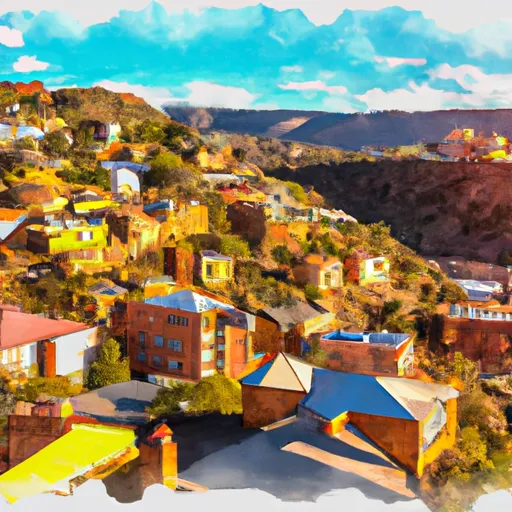-
 Snoflo Premium
Snoflo Premium
Get unlimited access to all our content
With no Ad interruptions! - Start Your Free Trial Login with existing account
Jerome
Eden Index
Climate
9.7
•
Recreation
7.5
•
Community
•
Safeguard
6.5/10

Jerome, Arizona, located in Yavapai County, is a historic mining town turned charming tourist destination. Situated at an elevation of around 5,000 feet, Jerome experiences a pleasant semi-arid climate. Summers are warm with average temperatures in the mid-80s to low 90s Fahrenheit, while winters are mild, ranging from the 40s to 60s.
Hydrologically, the town is located in the Verde River watershed, which provides water resources for the community. The Verde River is known for its diverse aquatic habitats and is home to various species of fish, birds, and wildlife.
Outdoor enthusiasts visiting Jerome can enjoy a variety of recreational opportunities. The town is surrounded by stunning natural landscapes, making it an ideal destination for hiking, mountain biking, and rock climbing. The nearby Prescott National Forest offers countless trails for exploration. Outdoor enthusiasts can also enjoy activities such as camping, fishing, and kayaking on the nearby Verde River.
Jerome's unique climate, hydrology constituents, and abundant outdoor recreation opportunities make it an appealing destination for nature lovers and adventure seekers alike.
What is the Eden Index?
The Snoflo Eden Index serves as a comprehensive rating system for regions, evaluating their desirability through a holistic assessment of climate health, outdoor recreation opportunities, and natural disaster risk, acknowledging the profound impact of these factors on livability and well-being.
Climate Health Indicator (CHI): 9.7
Jerome receives approximately
594mm of rain per year,
with humidity levels near 64%
and air temperatures averaging around
12°C.
Jerome has a plant hardyness factor of
8, meaning
plants and agriculture in this region tend to thrive here all year round.
By considering the ideal temperature range, reliable water supplies, clean air, and stable seasonal rain or snowpacks, the Climate Health Indicator (CHI) underscores the significance of a healthy climate as the foundation for quality living.
A healthy climate is paramount for ensuring a high quality of life and livability in a region, fostering both physical well-being and environmental harmony. This can be characterized by ideal temperatures, reliable access to water supplies, clean air, and consistent seasonal rain or snowpacks.
Weather Forecast
Streamflow Conditions
Verde
Area Rivers
Verde
Snowpack Depths
Verde
Reservoir Storage Capacity
Verde
Groundwater Levels
Recreational Opportunity Index (ROI): 7.5
The Recreational Opportunity Index (ROI) recognizes the value of outdoor recreational options, such as parks, hiking trails, camping sites, and fishing spots, while acknowledging that climate plays a pivotal role in ensuring the comfort and consistency of these experiences.
Access to outdoor recreational opportunities, encompassing activities such as parks, hiking, camping, and fishing, is crucial for overall well-being, and the climate plays a pivotal role in enabling and enhancing these experiences, ensuring that individuals can engage in nature-based activities comfortably and consistently.
Camping Areas
| Campground | Campsites | Reservations | Toilets | Showers | Elevation |
|---|---|---|---|---|---|
| Hazlett Hollow | 15 | 5,947 ft | |||
| White Horse Lake | 94 | 6,592 ft | |||
| Powell Springs | 10 | 5,301 ft | |||
| Potato Patch | 24 | 6,956 ft | |||
| Kentuck Springs | 15 | 6,016 ft | |||
| Dead Horse Ranch State Park | 127 | 3,323 ft | |||
| Mingus Mountain | 25 | 7,645 ft | |||
| Dogtown Lake | 54 | 7,058 ft | |||
| Agua Fria National Monument Dispersed | None | 3,186 ft | |||
| Thousand Trails Rd Dispersed | None | 3,461 ft |
Catastrophe Safeguard Index (CSI):
The Catastrophe Safeguard Index (CSI) recognizes that natural disaster risk, encompassing floods, fires, hurricanes, and tornadoes, can drastically affect safety and the overall appeal of an area.
The level of natural disaster risk in a region significantly affects safety and the overall livability, with climate change amplifying these risks by potentially increasing the frequency and intensity of events like floods, fires, hurricanes, and tornadoes, thereby posing substantial challenges to community resilience and well-being.
Community Resilience Indicator (CRI):
The Community Resilience Indicator (CRI) recognizes that education, healthcare, and socioeconomics are crucial to the well-being of a region. The CRI acknowledges the profound impact of these elements on residents' overall quality of life. By evaluating educational resources, healthcare accessibility, and economic inclusivity, the index captures the essential aspects that contribute to a thriving community, fostering resident satisfaction, equity, and social cohesion.

